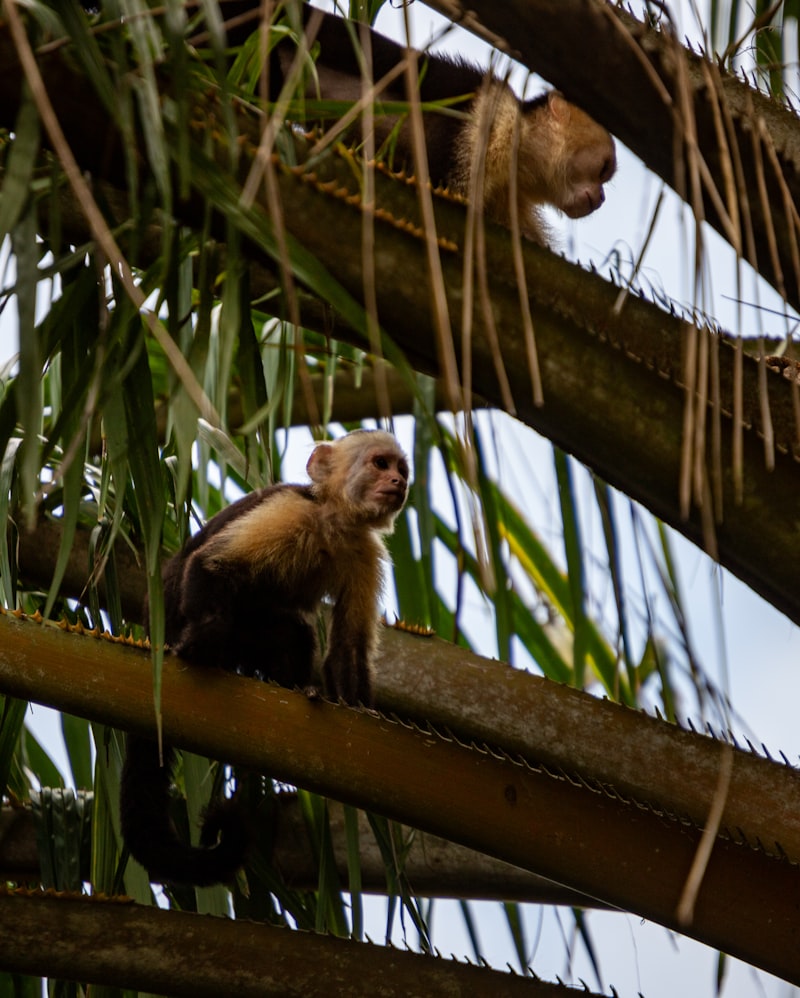Have you ever marveled at the agility of a spider monkey swinging effortlessly through the dense rainforest, or been captivated by the solemn gaze of a mountain gorilla in its natural habitat? Primates, our closest relatives in the animal kingdom, face numerous threats to their survival today. From habitat loss due to deforestation to illegal wildlife trade and climate change, these incredible creatures are in urgent need of conservation efforts to ensure their continued existence.
One of the primary threats facing primates worldwide is the loss of their natural habitat. As human populations grow, forests are cleared to make way for agriculture, infrastructure, and urbanization. This rapid deforestation not only destroys the homes of primates but also fragments their habitats, making it difficult for populations to thrive. Imagine a once lush forest now reduced to patches of isolated trees, leaving primates vulnerable and struggling to find food and shelter.
Illegal wildlife trade is another critical issue threatening primates. Chimpanzees, orangutans, and other primates are often captured and sold as pets or for their body parts. This illegal trade not only decimates wild populations but also subjects these intelligent animals to unimaginable suffering. It’s heartbreaking to think of a baby monkey torn from its mother and sold into captivity, all for the sake of human greed.
Climate change adds another layer of complexity to the challenges faced by primates. Rising temperatures, unpredictable weather patterns, and extreme events like droughts and floods disrupt their habitats and food sources. Species that are already on the brink of extinction, such as the Cross River gorilla or the Tapanuli orangutan, face an even greater risk of disappearing forever if we do not take immediate action.
Despite these daunting challenges, dedicated conservation efforts around the world are making a difference. National parks and protected areas provide safe havens for primates, allowing populations to recover and thrive. Conservation organizations work tirelessly to raise awareness, conduct research, and implement strategies to protect these vulnerable species.
By supporting sustainable practices, advocating for stronger laws against wildlife trafficking, and reducing our carbon footprint, each of us can play a role in conserving primates and their habitats for future generations. Together, we have the power to ensure that our closest relatives in the animal kingdom continue to swing through the trees and inspire awe for generations to come.
Vanishing Treasures: The Urgent Battle to Save Earth’s Primate Species
Imagine a world without the haunting call of the howler monkey echoing through the rainforest canopy or the playful antics of chimpanzees swinging effortlessly from tree to tree. This could become a reality if urgent action isn’t taken to protect these vanishing treasures.
At the heart of the issue lies habitat loss. As human populations expand and forests are cleared for agriculture, logging, and infrastructure development, primates lose crucial territories where they once thrived. Fragmented habitats make it difficult for populations to interconnect and breed, leading to genetic isolation and diminishing biodiversity.
Moreover, illegal wildlife trade poses a significant threat. Primates are captured and sold as pets or for their body parts, despite international regulations against such practices. This illicit trade not only decimates wild populations but also fuels organized crime networks, making it a complex challenge for conservationists to tackle.
Climate change further exacerbates these issues. Shifts in temperature and precipitation patterns disrupt the delicate balance of ecosystems, affecting the availability of food and water sources critical for primate survival. Species adapted to specific climatic conditions find themselves increasingly vulnerable to extinction as their habitats undergo rapid transformation.
In response to these challenges, conservation efforts are underway across the globe. Organizations collaborate with local communities to establish protected areas and promote sustainable land-use practices. Research into primate behavior and genetics informs strategies for captive breeding and reintroduction programs, aiming to bolster dwindling populations.
Behind the Numbers: Understanding the Threats Facing Primate Populations
Primate populations worldwide are facing unprecedented threats, casting a shadow over their future survival. These intelligent and charismatic creatures are key indicators of the health of our ecosystems, yet their numbers are dwindling at an alarming rate. But why exactly are primate populations declining, and what are the major threats they face today?
One of the most pressing issues is habitat loss. As human populations expand, forests are cleared for agriculture, logging, and urban development. This loss of habitat fragments primate populations, reducing their access to food sources and mating opportunities. Without adequate habitats, primates struggle to survive in fragmented patches of forest, making them more vulnerable to predation and competition.
Another significant threat is poaching and illegal wildlife trade. Primates, sought after for their meat, fur, and as pets, are often targeted by poachers. The demand for exotic pets and traditional medicines further fuels this illegal trade, pushing many primate species towards extinction. Despite conservation efforts, the illicit trade continues to thrive, posing a severe threat to primate populations globally.
Climate change adds another layer of complexity to the challenges facing primates. Rising temperatures, altered rainfall patterns, and extreme weather events disrupt primate habitats and food sources. Species adapted to specific climatic conditions struggle to cope with rapid environmental changes, leading to population declines and increased vulnerability to diseases.
Human-wildlife conflict is also a critical issue. As human populations encroach further into natural habitats, conflicts arise over resources such as crops and livestock. In response, primates may raid farms for food, leading to retaliatory killings by farmers. Such conflicts intensify as habitats shrink and resources become scarcer, exacerbating the pressures on primate populations.
In summary, the threats facing primate populations are multifaceted and interconnected. Habitat loss, poaching, climate change, and human-wildlife conflict all contribute to the decline of these iconic species. Effective conservation efforts must address these complex challenges holistically, involving local communities, governments, and global stakeholders to safeguard the future of primates and the ecosystems they inhabit.
From Deforestation to Disease: Unveiling the Perils Challenging Primate Conservation
Imagine a dense rainforest echoing with the calls of chimpanzees and the rustle of leaves disturbed by agile monkeys. This vibrant ecosystem, however, is under siege. Deforestation, driven by human activities like logging and agriculture, clears vast stretches of forest that primates call home. As their habitats shrink, primates are forced into smaller areas, making them more vulnerable to predators and human encounters. This loss of habitat not only threatens their existence but also disrupts the delicate balance of their ecosystems.
But deforestation isn’t the only menace lurking in the shadows of primate conservation. Diseases, both known and emerging, pose a significant threat. The recent outbreaks like Ebola and COVID-19 have highlighted how diseases can devastate primate populations. These viruses can spill over from humans to primates and vice versa, causing widespread mortality among already endangered species. As humans encroach further into primate territories, the risk of disease transmission escalates, creating a dangerous cycle of infection.
Moreover, illegal wildlife trade casts a dark shadow over primate conservation efforts. Primates, prized for their rarity and perceived medicinal value, are often captured and sold in clandestine markets. This illicit trade not only decimates wild populations but also fuels organized crime and threatens the biodiversity of entire regions.
In the face of these challenges, conservationists are racing against time to protect primates. Efforts range from establishing protected areas and corridors to conducting research on disease transmission dynamics. Public awareness campaigns and sustainable eco-tourism initiatives play crucial roles in promoting conservation ethics and funding critical projects.
As we navigate the intricate web of threats facing primate conservation, one thing becomes clear: the survival of these remarkable creatures depends on our collective actions. By addressing deforestation, combating disease outbreaks, and curbing illegal wildlife trade, we can secure a future where primates thrive in their natural habitats, ensuring biodiversity and ecological balance for generations to come.
Conservation Innovations: How Technology Is Reshaping Primate Protection
One of the foremost advancements is remote sensing technology. Through satellite imagery and drones, conservationists can track primate habitats with unparalleled precision. This aerial view not only monitors their numbers but also helps identify threats such as deforestation or illegal poaching in real-time. It’s like having a guardian angel watching over these majestic creatures, ensuring their safety from above.
Artificial Intelligence adds another layer of defense. Machine learning algorithms analyze vast datasets to predict behaviors and detect anomalies. Imagine AI as a sentinel, learning the nuances of primate communication and movement patterns to preempt dangers before they strike. It’s a proactive approach that turns the tide in favor of primate survival.
Moreover, innovative camera traps are game-changers in the field. These motion-sensitive devices capture candid moments of primate life, offering insights into their behavior without disturbing natural habitats. It’s akin to setting up hidden cameras in a wildlife documentary, revealing the secret lives of primates without intrusion.
In essence, these technological marvels aren’t just tools; they’re lifelines for primate conservation. They bridge the gap between human ingenuity and the natural world, ensuring that future generations can witness the beauty of primates in their natural habitats. As technology evolves, so too does our ability to protect these creatures, forging a path where conservation meets innovation seamlessly.
Saving Our Closest Relatives: Global Efforts to Preserve Primate Habitats
In Africa, where many primate species reside, initiatives are focusing on creating protected areas and promoting sustainable land use practices. Countries like Madagascar, known for its unique biodiversity, are implementing strict regulations to conserve the habitats of lemurs and other endangered primates. By establishing national parks and reserves, these efforts aim to maintain critical habitats and provide safe havens for primate populations.
In Southeast Asia, home to iconic species like orangutans and gibbons, conservation projects are tackling deforestation driven by palm oil plantations and logging. Organizations work closely with local communities to develop alternative livelihoods that reduce pressure on primate habitats. Reforestation programs are also underway to restore damaged areas and reconnect fragmented forests, allowing primates to move freely and find food sources.
In the Amazon rainforest, efforts are underway to protect the habitats of spider monkeys, howler monkeys, and other primates threatened by illegal logging and agricultural expansion. Conservationists collaborate with indigenous communities to manage protected areas effectively, preserving biodiversity while respecting cultural traditions.
Global partnerships and international agreements play a pivotal role in primate habitat conservation. Organizations like the International Union for Conservation of Nature (IUCN) coordinate efforts across borders, sharing knowledge and resources to tackle large-scale challenges. Funding from governments, NGOs, and private donors supports field research, habitat restoration, and community outreach programs aimed at securing a future for primates in the wild.


As awareness grows about the importance of primate conservation, individuals can also make a difference through sustainable consumer choices and supporting ethical wildlife tourism. Every action counts in safeguarding the habitats of our closest relatives and ensuring they thrive for generations to come.
Breaking Point: Why Primate Species Are Facing a Critical Conservation Crossroads
Imagine a world where the haunting calls of orangutans echoing through the misty Indonesian forests fade into silence, or where the playful antics of chimpanzees in the African plains become a distant memory. This scenario is becoming increasingly plausible as primate habitats shrink due to deforestation, human encroachment, and climate change.
The urgency of primate conservation cannot be overstated. With over half of primate species now listed as endangered or critically endangered, the need for immediate action is paramount. Organizations and scientists are racing against time to protect remaining habitats, establish conservation programs, and raise awareness about the plight of these intelligent beings.
What makes primates so vulnerable? Their slow reproductive rates and specialized diets make them particularly susceptible to habitat loss and environmental changes. For example, the mountain gorilla, with its limited range in the Virunga Mountains, faces constant threats from poaching and habitat fragmentation.
Despite these challenges, there is hope. Conservation efforts, such as establishing protected areas and promoting sustainable practices among local communities, have shown promising results. Efforts like these not only safeguard primate populations but also contribute to the broader goal of preserving biodiversity and ecosystems.
The future of primate species hangs in the balance. By understanding the root causes of their decline and taking decisive action now, we can ensure that future generations will still marvel at the grace of a swinging gibbon or the intelligence of a tool-using macaque. The time to act is now—before we reach a point where the silence of a forest devoid of primates becomes our new reality.
Frequently Asked Questions
What are the main threats facing primate populations today?
Learn about the primary threats endangering primate populations worldwide today, including habitat loss, illegal wildlife trade, climate change impacts, and disease outbreaks.
How do conservation efforts help protect endangered primate species?
Learn how conservation efforts play a crucial role in safeguarding endangered primate species through habitat preservation, anti-poaching measures, and community education. Discover how proactive conservation initiatives contribute to the survival and thriving populations of these vulnerable animals.
How can habitat loss be mitigated to conserve primate populations?
Learn effective strategies to mitigate habitat loss and protect primate populations with targeted conservation efforts, including habitat restoration, sustainable land use practices, and community engagement.
What are successful examples of primate conservation initiatives worldwide?
Explore successful primate conservation initiatives worldwide, highlighting impactful efforts that have preserved endangered species and their habitats. Learn about innovative approaches and collaborations driving positive outcomes in primate protection.
What role do local communities play in primate conservation?
Local communities play a crucial role in primate conservation by providing support for sustainable practices, reducing human-wildlife conflict, and promoting habitat protection. Their involvement ensures conservation efforts are culturally sensitive and economically beneficial, contributing to long-term primate survival.


